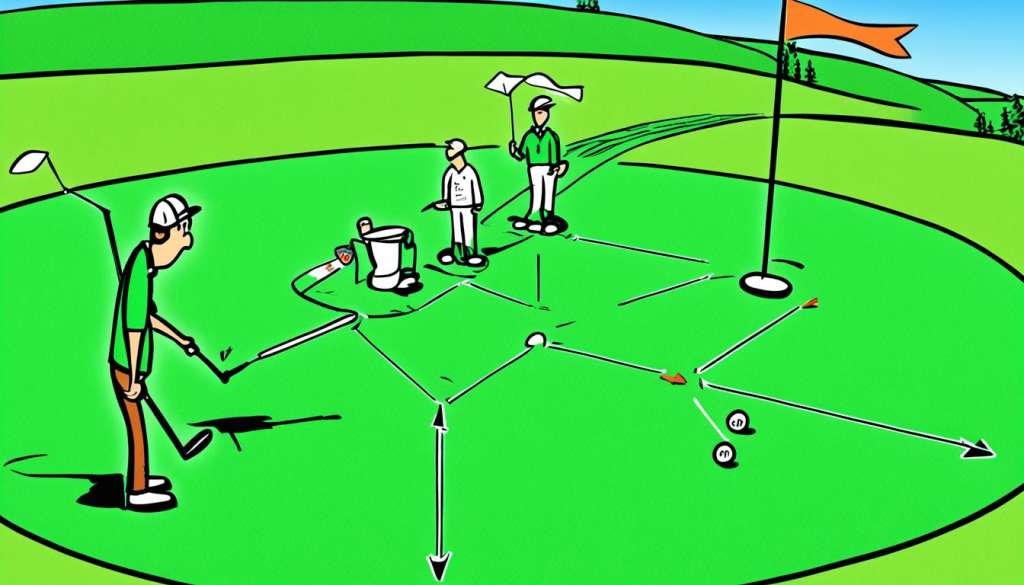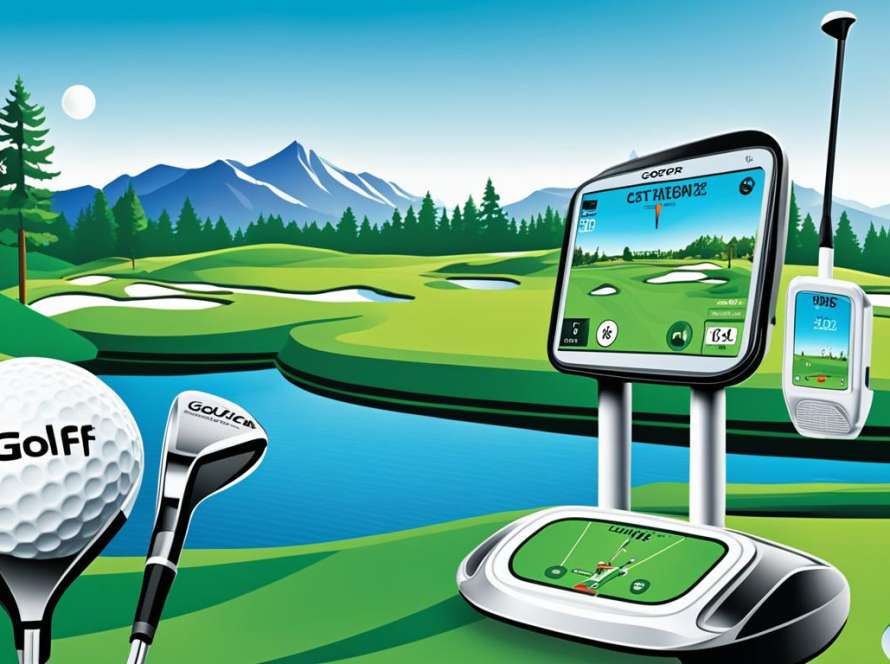Want to boost your golf game? A detailed golf performance guide can help. It covers everything from pre-shot routines to swing mechanics. This way, you’ll improve every part of your game.
This guide breaks the game into easy parts. It focuses on mental strategies, physical conditioning, and managing the course. By using this guide, you’ll learn to plan each shot carefully.
It shows how important pre-shot and post-shot routines are. These routines keep you focused and help you learn from each swing. You’ll see how to use data to track your progress and set goals for getting better.
Whether you’re just starting or you’ve been playing for years, this guide has great tips to improve your skills. It’s time to improve your golf game with a step-by-step approach.
Understanding the Importance of a Golf Performance Guide
A golf performance guide is like a roadmap for getting better at golf. It’s a detailed plan that helps you tackle the game’s challenges. It’s key for improving your golf skills.
Defining Golf Performance
Golf performance is more than just your score. It covers your technical skills, mental strength, physical shape, and how you make decisions. A good guide looks at all these to make you a better player.
Benefits of Following a Structured Guide
Using a structured golf improvement plan has many benefits:
- Consistent progress tracking
- Targeted skill development
- Improved time management during practice
- Enhanced motivation and goal-setting
Key Components of a Comprehensive Golf Performance Guide
A good golf guide should have:
| Component | Purpose |
|---|---|
| Pre-shot routines | Enhance focus and consistency |
| Swing mechanics analysis | Improve technical skills |
| Mental game techniques | Boost confidence and manage stress |
| Physical conditioning | Increase strength and flexibility |
| Course management strategies | Optimize decision-making on the course |
By using these elements, you get a full plan for improving your golf. This approach covers everything from your swing to your mental game. Remember, keeping track of your golf performance helps you see how you’re doing and improve your strategy.
Pre-Shot Routines: Setting the Foundation for Success
Your golf pre-shot routine is key to playing well consistently. It has two main parts: deciding on your shot and executing it. Both are crucial for getting ready for a good shot.
Choosing your action is the first step in the decision routine. You might use yardage books, practice swings, or advice from your caddy. This part involves talking, moving quickly, and thinking deeply. You’re deciding the best way to hit your shot.
After deciding, it’s time for the execution routine. This is when you actually hit the shot you planned. It’s quiet and slow, focusing on feeling and sensing, not just thinking.
Resonance frequency breathing is a big part of the execution routine. It helps calm your nerves and keep you focused before you hit your shot.
- Decision routine: Analyze and plan
- Execution routine: Focus and perform
- Use tools like yardage books and practice swings
- Incorporate resonance frequency breathing
Mastering your golf pre-shot routine sets you up for success. Being consistent with your routine means you’ll play more consistently too.
Mastering Golf Swing Mechanics
Golf swing mechanics are key to playing well. They help you hit the ball more accurately, farther, and consistently. Let’s explore how to improve your swing.
The Basics of a Proper Golf Swing
A good golf swing begins with the right grip, stance, and posture. Start by gripping the club firmly but not too hard. Stand with your feet shoulder-width apart and your body parallel to the target line. Keep a slight bend in your knees.
Common Swing Flaws and How to Correct Them
Many golfers face swing flaws that affect their game. Common problems include:
- Over-the-top motion: Start the downswing with your lower body
- Early release: Keep the angle between your wrists and club shaft longer
- Reverse pivot: Keep your spine angle steady throughout the swing
Fixing these flaws with practice and drills can greatly improve your swing.
Utilizing Technology for Swing Analysis
Today’s golf swing analysis tools are very helpful. Launch monitors show your ball’s speed, spin, and launch angle. Video analysis lets you see your swing in slow motion, pointing out what to work on. These tools help you make smart changes to your swing.
| Technology | Benefits | Key Metrics |
|---|---|---|
| Launch Monitors | Precise ball flight data | Ball speed, spin rate, launch angle |
| Video Analysis | Visual feedback on swing mechanics | Swing path, club face angle, body positioning |
| Pressure Plates | Insight into weight distribution | Center of pressure, weight shift timing |
Focus on proper swing mechanics, fix common flaws, and use analysis tools to improve your golf. Remember, practice and patience are essential for mastering your swing.
Mental Game Strategies for Optimal Performance
The mental game in golf is key to your success. Learning how to handle your mind can make you play better and keep you focused. Here are some strategies to help you focus and concentrate better.

Visualization is a strong tool for your mind. Before you hit the ball, imagine where you want it to go. This helps your brain get ready for success and builds confidence. Also, talk positively to yourself, remembering your past wins and believing in your skills.
Deep breathing helps you stay calm when it matters most. Practice breathing deeply to relax and focus better. Try the 4-7-8 method: breathe in for 4 seconds, hold for 7, and breathe out for 8. This can help you stay calm and focused.
Having a routine after each shot is also crucial. Take a moment to think about how you did. Look for what you can learn from it to improve your next shot. This helps you learn and adapt on the course.
| Mental Strategy | Benefit | Implementation |
|---|---|---|
| Visualization | Improved shot accuracy | Picture ideal shot before swinging |
| Positive Self-Talk | Increased confidence | Use affirming statements |
| Breathing Exercises | Stress reduction | Practice 4-7-8 technique |
| Post-Shot Routine | Enhanced learning | Reflect after each stroke |
Using these mental strategies in your golf game will strengthen your mental game. Remember, practicing these techniques regularly is the best way to improve your mental golf skills.
Physical Conditioning for Golfers
Golf fitness is key to bettering your game and avoiding injuries. A good physical conditioning plan boosts your swing power, endurance, and overall performance on the course.
Strength Training Exercises for Golf
Strength training for golfers aims to build power in muscles used in your swing. Here are some golf-specific exercises to try:
- Standing cable chest press
- Incline dumbbell press
- Squats
- Lunges
- Lat pull-downs
Work out for 30 minutes daily to see big improvements in your golf game. These exercises focus on muscles used in your swing. They help you swing harder and keep good form during your game.
Flexibility and Mobility Workouts
Being flexible is key for a smooth golf swing. Add these stretches to your routine:
- Hip rotations
- Shoulder rolls
- Torso twists
- Hamstring stretches
- Wrist flexor and extensor stretches
Stretching regularly boosts your flexibility. This reduces injury risk and lets you swing more powerfully and fully.
Nutrition Tips for Golf Performance
Good nutrition keeps your energy up during golf. Here are some tips:
| Nutrient | Purpose | Food Sources |
|---|---|---|
| Complex Carbohydrates | Sustained energy | Whole grains, fruits, vegetables |
| Lean Proteins | Muscle recovery | Chicken, fish, tofu |
| Healthy Fats | Joint health | Nuts, avocados, olive oil |
| Hydration | Mental focus | Water, electrolyte drinks |
Combine strength training, flexibility exercises, and good nutrition for better golf performance. Always talk to a fitness expert to make these plans fit your needs and goals.
Course Management and Strategic Play
Golf course management and strategic play are key to improving your game. Making smart decisions on the course can really lower your score. Let’s look at some strategies to boost your performance.

Choosing the right club is crucial. Think about the distance, wind, and hazards before picking a club. Don’t always go for the driver. Sometimes, a safer choice with a lower-lofted club can keep you in good position for your next shot.
Where you aim your shot is also very important. Aim for the widest part of the fairway to hit it well. When heading towards the green, think about the pin’s location and any dangers around it. Playing to the green’s center is usually safer than aiming for a tough pin.
Adjusting to the course’s conditions is key. Wet fairways mean less roll on your shots, while hard conditions might mean choosing a safer club to avoid going too far.
| Course Element | Strategic Approach |
|---|---|
| Dogleg holes | Position your tee shot for the best angle into the green |
| Water hazards | Play away from the hazard, even if it means a longer approach shot |
| Bunkers | Aim for the side of the fairway or green opposite the bunkers |
| Elevated greens | Club up to ensure you reach the putting surface |
Using a yardage guide can really help with your shot planning. These guides show you the course layout, helping you make better shots. Keep an eye on hazards and green shapes to plan your strategy.
Smart course management means playing within your skill level. Don’t try shots you’re not good at, especially when it’s tense. By focusing on strategic play and making wise decisions, you’ll see better scores and performance.
Analyzing Your Game: Using Data to Improve
Golf performance analysis has changed how players get better. By using data, you can find areas to work on and see how you’re doing over time. Let’s explore golf metrics and launch monitor data to help you improve your game.
Understanding Golf Performance Metrics
Golf performance metrics give you insights into different parts of your game. Key stats include:
- Driving distance
- Fairways hit
- Greens in regulation
- Putts per round
- Scrambling percentage
These metrics show your strengths and weaknesses. This lets you focus your practice and improve your game.
Interpreting Launch Monitor Data
Launch monitor data gives you a closer look at your swing. Modern devices track:
| Metric | Description | Impact on Performance |
|---|---|---|
| Club head speed | Velocity of the club at impact | Influences distance and power |
| Ball spin rate | Rotation of the ball after impact | Affects trajectory and control |
| Launch angle | Angle of the ball’s initial flight | Determines peak height and distance |
| Smash factor | Efficiency of energy transfer | Indicates quality of strike |
Knowing these metrics helps you improve your swing for better ball flight and control.
Tracking Progress and Setting Goals
Tracking your progress is key to getting better over time. Use data from both your games and practice to set goals you can reach. Analyzing your stats regularly will show you trends and help you focus your training. Remember, getting better takes time, so celebrate your small wins along the way.
Advanced Techniques for Experienced Golfers
Ready to take your golf game to the next level? Advanced golf techniques can help you become a true master of the course. Let’s dive into some expert strategies that will elevate your performance.
Golf shot shaping is a crucial skill for experienced players. By manipulating the club face and swing path, you can create draws, fades, and even intentional hooks or slices. This control over ball flight allows you to navigate around obstacles and attack pins with precision.
Specialized golf shots are another area where you can gain an edge. The flop shot lets you loft the ball high and soft, perfect for clearing bunkers or landing on tight greens. The stinger, a low, penetrating shot, is ideal for windy conditions or when you need to keep the ball under tree branches.
Mastering distance control with wedges is essential for scoring well. Practice hitting flighted wedges at various trajectories to improve your accuracy from 100 yards and in. And don’t forget about developing a reliable fairway finder off the tee – sometimes, accuracy trumps distance for overall scoring.

